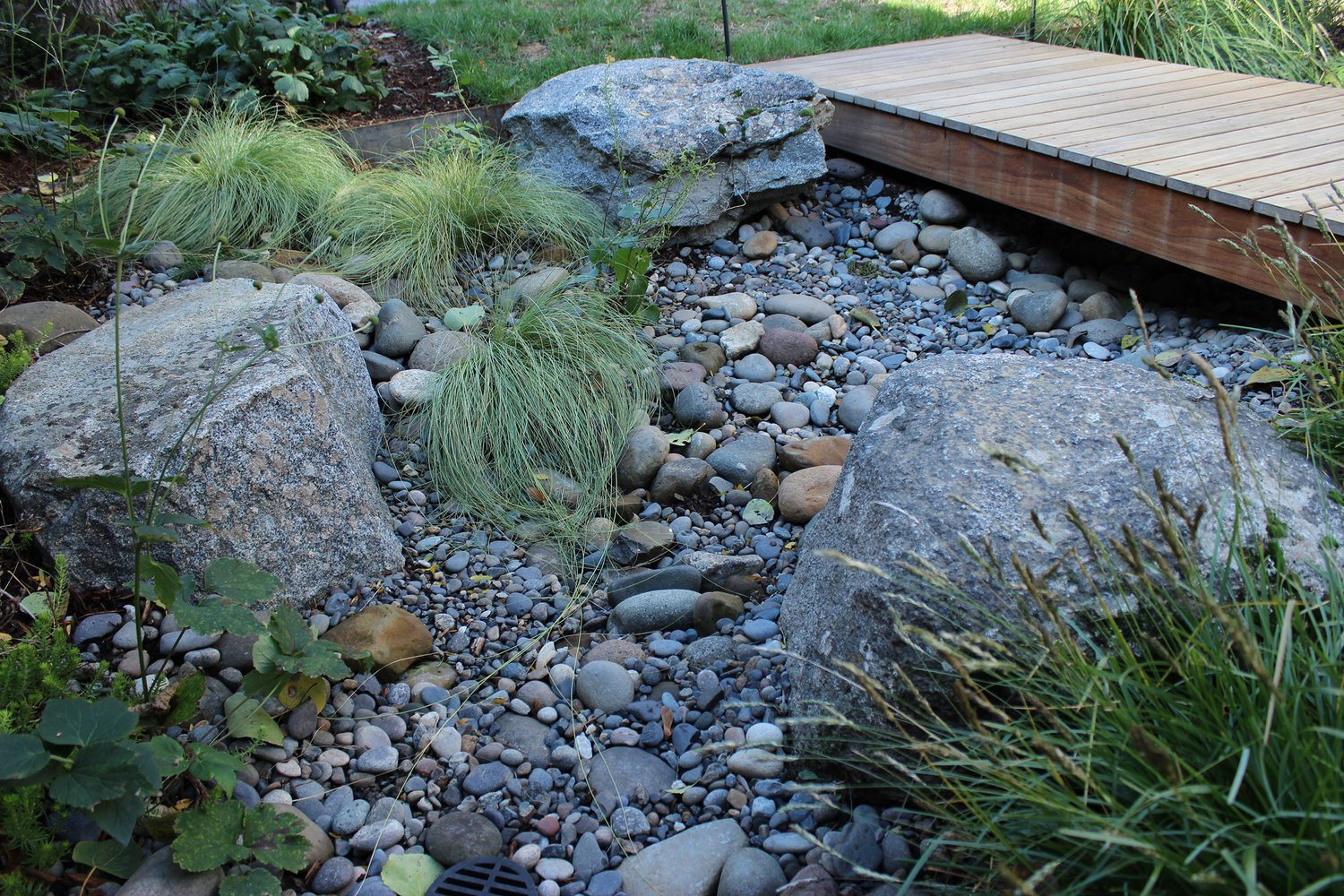Rain GardenS
Blueprint Earth: Discover why rain gardens are essential for the Pacific Northwest—and how to create one.
Have you ever looked at the water puddling by your foundation and wondered how to make sure it doesn't flood your basement or crack your foundation?
The solution? A well-designed drainage and landscaping strategy, such as installing a rain garden or redirecting water flow, can protect your foundation and give you several added benefits.
Why Rain Gardens Are Essential for the Pacific Northwest—and How to Create One
In Portland, Oregon, and the broader Pacific Northwest, heavy rainfall is a part of life. While it keeps our landscapes lush and green, it can also lead to stormwater runoff, erosion, and water pollution. A rain garden is a natural solution to manage this runoff, filter pollutants, and prevent flooding—all while adding beauty and sustainability to your landscape.
Why Rain Gardens Are So Important
Rain gardens capture stormwater, allowing it to soak into the ground instead of running into storm drains. This helps reduce runoff, filter harmful pollutants like oils and fertilizers, and supports healthier ecosystems. In the Pacific Northwest, where rain is frequent, can make a significant impact on managing water and protecting local waterways.
An illustrated guide to designing a rain garden with native plants, natural boulders, and proper drainage for the Pacific Northwest.
How to Create a Rain Garden in 5 Easy Steps
1. Choose the Right Location
Pick a low area in your yard where water naturally collects. Avoid placing it less than 10' from your home’s foundation.
2. Size It Right
This is so important. Below we lay out the formula in detail.
3. Prepare the Soil
After you've sized it right, dig your swale to the appropriate size. Mix in organic matter like compost to improve drainage. Well-draining soil is crucial for water absorption.
4. Pick the Right Plants
Choose native plants that thrive in both wet and dry conditions, such as Oregon grape, sedges, or ferns. Native landscaping in Portland, Oregon, supports local wildlife and adapts to the PNW climate.
5. Boulders + Rocks
Layer in boulders and rocks to make a naturalized pattern like the edge of a riverbank. Use different sizes of boulders and river rock from 2"-basketball or even bench size.
6. Mulch and Maintain
Top with mulch to retain moisture and suppress weeds. Rain gardens are low-maintenance but need occasional checks and watering during dry spells.
A Pacific Northwest rain garden designed with natural boulders, river rocks, and native grasses to manage stormwater while enhancing the landscape’s beauty.
Blueprint Earth’s Approach to Installing a Rain Garden
At Blueprint Earth, we start by evaluating your landscape to find the best location for the rain garden based on where water naturally flows. Our team then assesses your soil and designs a garden using native plants that thrive in our climate. We handle the full installation, from digging and preparation to planting, ensuring your rain garden integrates seamlessly into your landscape. We also provide ongoing guidance to ensure it functions effectively for years to come.
If you’re ready to manage stormwater and add a beautiful, sustainable element to your yard, contact Blueprint Earth. Let us help you create the perfect rain garden for your property.
How To Calculate Rain Garden Square Footage
To calculate the size of your rain garden, you need to determine the area of the surface from which it will collect water (such as a roof, driveway, or patio) and then use a simple formula based on runoff and infiltration rates. Here's a step-by-step guide:
1. Determine the Area of Runoff
Start by measuring the area of the surface from which water will flow into the rain garden. This includes the roof, driveway, patio, or any other impermeable surface.
For roofs: Measure the length and width of your roof and multiply the two numbers to get the square footage.
For driveways or patios: Measure the length and width of these surfaces as well, then multiply them together for the total area.
Example: If you have a roof that is 30 feet long and 20 feet wide, the total area is 600 square feet.
2. Calculate the Rain Garden Size
A general rule is that your rain garden should be about 20-30% of the area of the impervious surface that drains into it. This allows enough space for the rainwater to soak into the soil without overflowing.
Formula: Rain Garden Size = Runoff Area × 0.2 to 0.3
3. Adjust for Soil Type
Soil plays a role in how much water it can absorb. If you have sandy or well-draining soil, your rain garden can be smaller. If you have clay or poorly draining soil, it may need to be larger.
Sandy soil: Use the lower end of the range (about 20% of runoff area).
Clay soil: Use the higher end (about 30% of runoff area).
Example Calculation
If your roof is 600 square feet, and you have well-draining soil:
600 sq ft × 0.2 = 120 sq ft (smaller rain garden)
600 sq ft × 0.3 = 180 sq ft (larger rain garden)
So, your rain garden should be between 120-180 square feet in size, depending on soil drainage.
Zooming in on the details: A rain garden’s layered textures, from river rocks to drought-tolerant grasses, work together to manage stormwater while adding natural beauty.
Final Thoughts
This general formula gives you a good starting point, but for best results, especially for larger properties or more complex runoff situations, consulting with a landscape professional or engineer can help ensure the rain garden is properly sized and designed for your unique site conditions. We’ve designed and built rain gardens in Portland and beyond, and we’d love to hear about your vision or help bring your rain garden plans to life. Contact us to share your rain garden needs.




